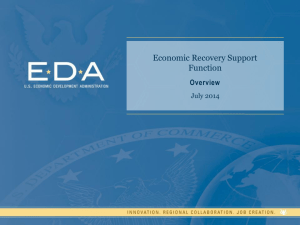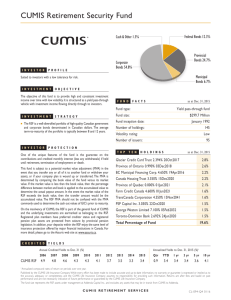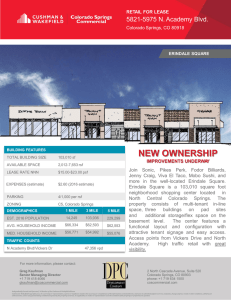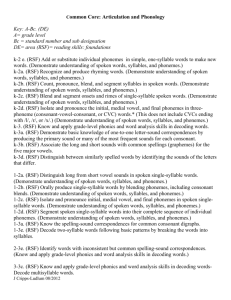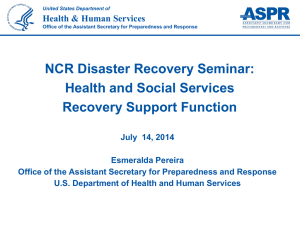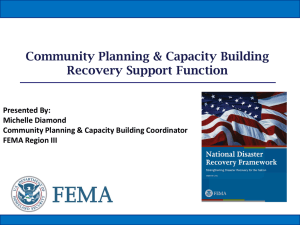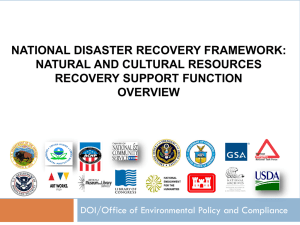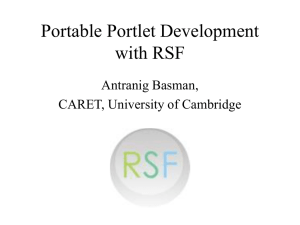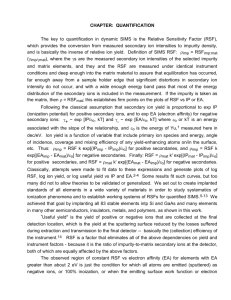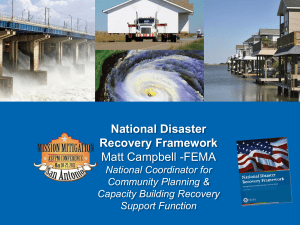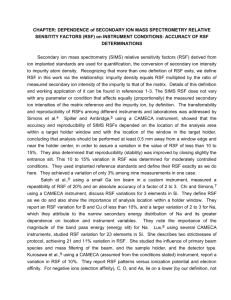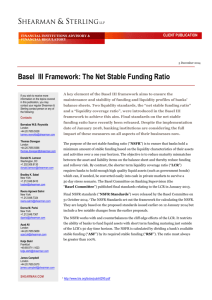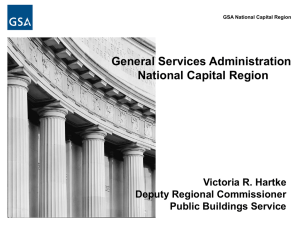Panel 1 - Infrastructure RSF
advertisement
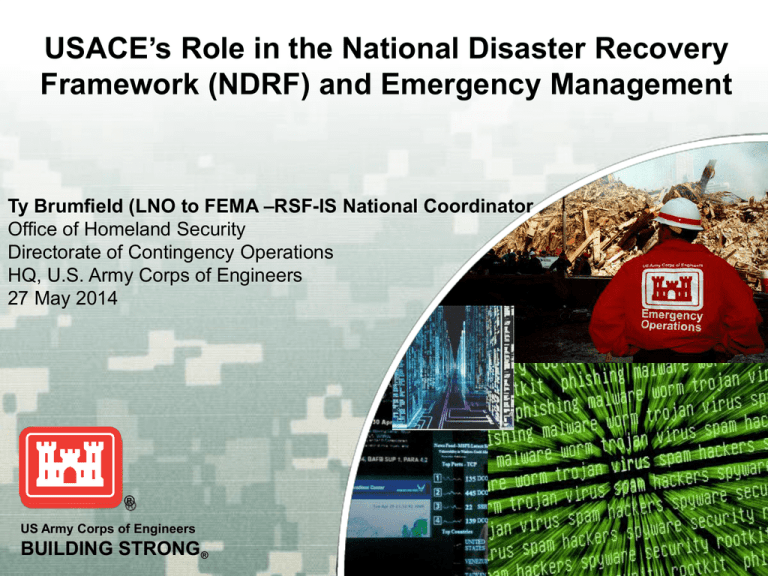
USACE’s Role in the National Disaster Recovery Framework (NDRF) and Emergency Management Ty Brumfield (LNO to FEMA –RSF-IS National Coordinator Office of Homeland Security Directorate of Contingency Operations HQ, U.S. Army Corps of Engineers 27 May 2014 US Army Corps of Engineers BUILDING STRONG® What is the NDRF? • The NDRF is a companion document to the National Response Framework (NRF) which deals with immediate disaster response (perform “Triage”) and it is supported by the ongoing development of detailed operational, management, field guidance, and training tools for dealing specifically with the Recovery efforts (perform “Physical Therapy”) short, immediate, and long term. • A guide to promote effective Recovery, particularly for those incidents that are large-scale or catastrophic. • NDRF applies to all Presidentially declared major disasters – invokes the Stafford Act. NDRF is defined by: • Roles and Responsibilities of Recovery Coordinators and other Stakeholders • A Coordinating Structure (USACE) that facilities communication and collaboration among all stakeholders • Guidance for Pre- and Post Disaster Recovery Planning What is Infrastructure Systems under the NDRF? The Scope of this RSF includes the following Infrastructure Sector and Subsectors (as defined through the NIPP – National Infrastructure Protection Plan – 18 Sectors/16 Sectors defined in PPD21) energy, water/waste water, dams, manufacturing, communications, transportation systems, Agricultural (food production and delivery), chemical, financial services, defense industrial base, nuclear reactors, emergency services, government facilities, commercial facilities, IT, and healthcare and public health. Two former sectors: National Monuments and Icons falls under Government Facilities and Postal and Shipping falls under the Transportation Systems. Infrastructure Systems Recovery Support Function Agencies and their roles COORDINATING AGENCY PRIMARY AGENCIES SUPPORTING AGENCIES Intro to the RSF & its Capabilities The goal of the infrastructure systems recovery process is to match the capacity of all infrastructure systems to a community’s current and projected demand on its built and virtual environment • The IS RSF’s will pursue this course of action to the extent allowable by available resources and current program authorities. • Accordingly, the end-state for IS RSF engagement occurs when infrastructure systems recovery goals are met OR • When IS RSF member agencies’ existing programs and authorities are exhausted and/or external funding is no longer available to continue operations. Pre-Disaster: Infrastructure RSF • Develops guidance and standard procedures for rapid activation of RSF capabilities to support community recovery. • Identifies relevant statutory and/or regulatory programs, potential capabilities and/or limiting factors pertaining to recovery support for infrastructure systems. • Provides a forum for interagency coordination, information sharing and exchange of effective practices. • Supports planning, preparedness, education, training and outreach efforts to enhance capabilities for recovery. • Works with partners to identify critical facilities and ensure considerations are made to reduce risk pre- and post-disaster. Post-Disaster: Infrastructure RSF • When activated by the FDRC, the primary and supporting departments and agencies deploy in support of the Infrastructure Systems RSF mission. • Supports the recovery of infrastructure systems, dependent on the nature and scope of the disaster, and the specific authorities and programs within the jurisdiction of participating departments and agencies. • Participates in the national-level coordination of damage and community needs assessments as appropriate to ensure infrastructure considerations integrate into the post- disaster public and private sector community planning process. • Deploys RSF resources, as required by the specific disaster situation and consistent with the specific authorities and programs of the participating departments and agencies, to the field to assist the affected community in developing an Infrastructure Systems Recovery action plan that: Post-Disaster: Infrastructure RSF • Avoids the redundant, counterproductive, or unauthorized use of limited capital resources necessary for Infrastructure/recovery. • Helps resolve conflicts, including those across jurisdictional lines, resulting from the competition for key resources essential to infrastructure systems recovery. • Sets a firm schedule and sequenced time structure for future infrastructure recovery projects. • Works with RSF partners to leverage available financial and technical assistance, both from governmental and nongovernmental sources, in the execution of the community’s from governmental and non-governmental sources in the execution of the community’s Infrastructure Systems Recovery action plan. Summary of IOP & RSF Annex • RSF Activation and Deployment – If deemed necessary, the FDRC can request that the IS RSF be deployed via: • Mission Assignment • Interagency Agreement • Other non-Stafford Act authorities – USACE will coordinate the deployment of their staff as well as those from primary and supporting agencies and organizations. Summary of IOP & RSF Annex • Recovery Support Strategy Development – Step 1: Mission Scoping Assessment • Work in support of the FDRC to determine disaster impacts on infrastructure systems and the scope of services needed to help address those impacts • Take full advantage of existing infrastructure data, preincident studies and post-incident response-phase damage assessments • A task force may be formed with relevant subject matter experts to augment the MSA Summary of IOP & RSF Annex • Recovery Support Strategy Development – Step 2: Develop the Recovery Support Strategy • Built upon the Mission Scoping Assessment • The IS RSF will work with the FDRC to identify which member agencies and organizations are needed, and their strategy and approach in supporting local, state, tribal, and territorial government officials • The IS RSF will help the FDRC determine the scope and duration of support needed Summary of IOP & RSF Annex • Recovery Support Strategy Kickoff and Implementation – Most challenging aspect and primary focus of IS RSF support effort – Focused on providing communities, as necessary, help with funding and execution of multiple complex infrastructure projects – Work to coordinate and leverage other potential sources of assistance Summary of IOP & RSF Annex • Actions the IS RSF may take to implement the RSS include: – Technical assistance for the physical assessment, planning, construction and ultimate recovery of community infrastructure assets – Grants or loans to help both public and private entities finance the capital costs of recovering an infrastructure asset, and/or to finance the operational costs of the infrastructure – Disaster assistance programs that may reduce risk through mitigation and disaster-resilient construction – Maximization of Federal, state, tribal, territorial and local governments’ legal authorities and regulations to support the community recovery process Questions?
